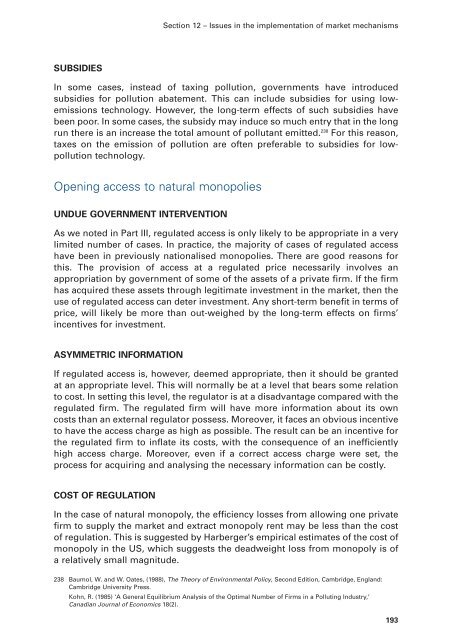Public Policy: Using Market-Based Approaches - Department for ...
Public Policy: Using Market-Based Approaches - Department for ...
Public Policy: Using Market-Based Approaches - Department for ...
Create successful ePaper yourself
Turn your PDF publications into a flip-book with our unique Google optimized e-Paper software.
SUBSIDIES<br />
In some cases, instead of taxing pollution, governments have introduced<br />
subsidies <strong>for</strong> pollution abatement. This can include subsidies <strong>for</strong> using lowemissions<br />
technology. However, the long-term effects of such subsidies have<br />
been poor. In some cases, the subsidy may induce so much entry that in the long<br />
run there is an increase the total amount of pollutant emitted. 238 For this reason,<br />
taxes on the emission of pollution are often preferable to subsidies <strong>for</strong> lowpollution<br />
technology.<br />
Opening access to natural monopolies<br />
UNDUE GOVERNMENT INTERVENTION<br />
As we noted in Part III, regulated access is only likely to be appropriate in a very<br />
limited number of cases. In practice, the majority of cases of regulated access<br />
have been in previously nationalised monopolies. There are good reasons <strong>for</strong><br />
this. The provision of access at a regulated price necessarily involves an<br />
appropriation by government of some of the assets of a private firm. If the firm<br />
has acquired these assets through legitimate investment in the market, then the<br />
use of regulated access can deter investment. Any short-term benefit in terms of<br />
price, will likely be more than out-weighed by the long-term effects on firms’<br />
incentives <strong>for</strong> investment.<br />
ASYMMETRIC INFORMATION<br />
If regulated access is, however, deemed appropriate, then it should be granted<br />
at an appropriate level. This will normally be at a level that bears some relation<br />
to cost. In setting this level, the regulator is at a disadvantage compared with the<br />
regulated firm. The regulated firm will have more in<strong>for</strong>mation about its own<br />
costs than an external regulator possess. Moreover, it faces an obvious incentive<br />
to have the access charge as high as possible. The result can be an incentive <strong>for</strong><br />
the regulated firm to inflate its costs, with the consequence of an inefficiently<br />
high access charge. Moreover, even if a correct access charge were set, the<br />
process <strong>for</strong> acquiring and analysing the necessary in<strong>for</strong>mation can be costly.<br />
COST OF REGULATION<br />
Section 12 – Issues in the implementation of market mechanisms<br />
In the case of natural monopoly, the efficiency losses from allowing one private<br />
firm to supply the market and extract monopoly rent may be less than the cost<br />
of regulation. This is suggested by Harberger’s empirical estimates of the cost of<br />
monopoly in the US, which suggests the deadweight loss from monopoly is of<br />
a relatively small magnitude.<br />
238 Baumol, W. and W. Oates, (1988), The Theory of Environmental <strong>Policy</strong>, Second Edition, Cambridge, England:<br />
Cambridge University Press.<br />
Kohn, R. (1985) ‘A General Equilibrium Analysis of the Optimal Number of Firms in a Polluting Industry,’<br />
Canadian Journal of Economics 18(2).<br />
193
















